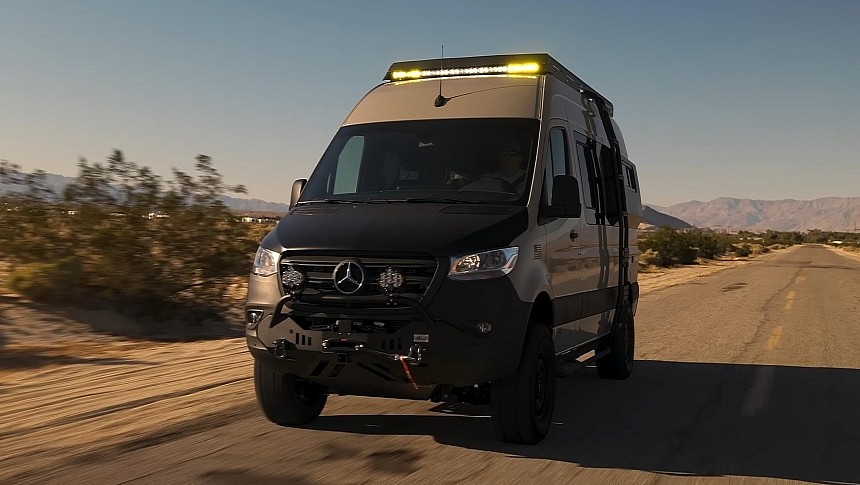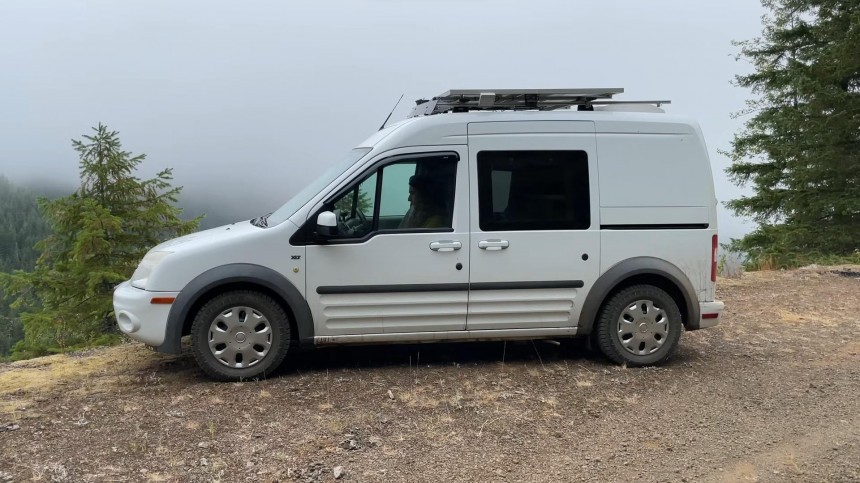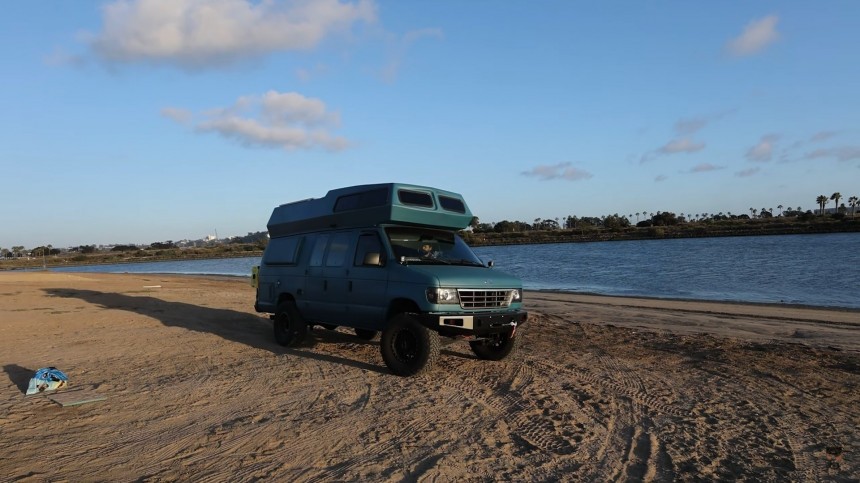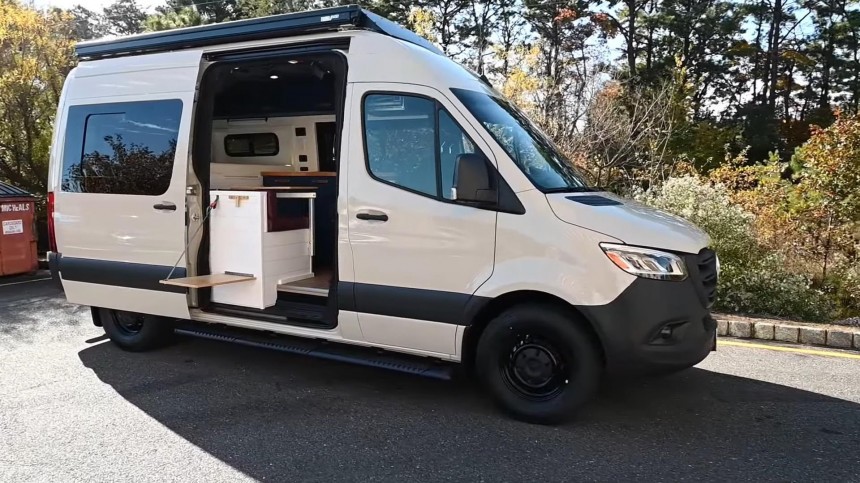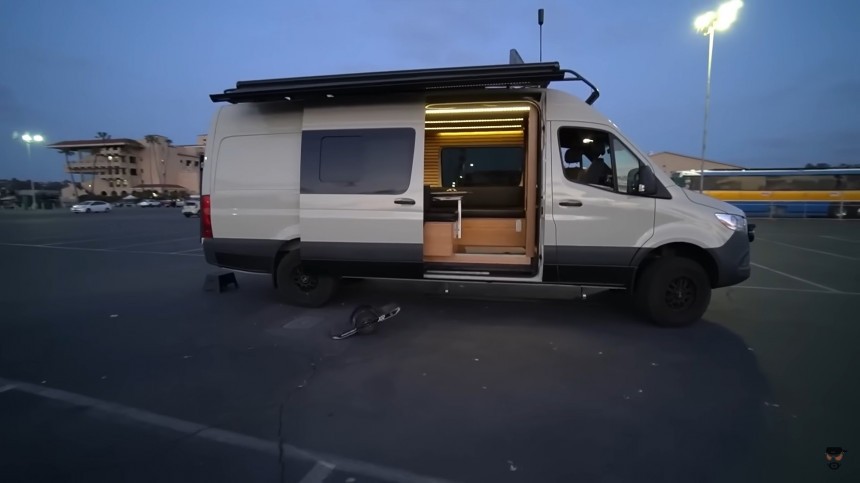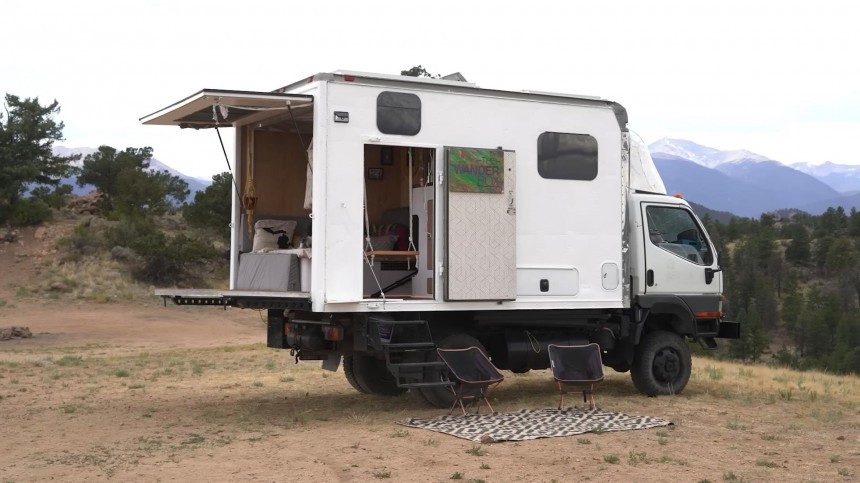Choosing the right base vehicle is one of the most important steps in making a camper conversion. And there isn't any one-size-fits-all solution – you need to figure out your exact needs and wants, budget, and purpose for the camper, and you start from there. Today, I want to make things easier for you by making a list of the main types of vehicles that can be converted, along with some pros and cons for each.
But first, let's get something out of the way that might be confusing for some: the meaning of the word "camper." In the general sense, any pull-type RV, including truck camper, travel trailers, or pop-up trailers, is referred to as a camper; however, lately, people have started using RV and camper interchangeably.
A lot of you, like me, will probably associate the word "camper" with "van" since camper vans are extremely popular nowadays. Vans are by far the go-to option for conversions, and for good reason. I have identified five main types of camper van types.
Some are better for extra space, others are ideal for stealth camping, and some can help you keep conversion costs as low as possible. I'll provide an example for each of the types.
A micro camper van is classified as a converted MPV (multi-purpose vehicle) or a car-derived rig that offers around three to four cubic meters (106 to 141 cubic feet) of interior space.
The most common base vehicles in this category are the Ford Transit Connect and the Volkswagen Caddy. Still, there are multiple other models, such as the Citroen Berlingo or the Mercedes-Benz Citan, that are suitable for a micro camper conversion. Naturally, because of their compact size, these small vehicles are the easiest and most budget-friendly to convert. Moreover, they're the perfect choice for a single traveler, although two people can be accommodated if you're okay with a more cramped experience.
So, why would you choose a micro camper van? Well, there are multiple advantages. First of all, they only have a little interior space, so transforming it will not empty your bank account. Second, these types of vehicles have excellent fuel economy.
Driving a micro camper van isn't much different from driving a standard car, so maneuvering and parking are easy. By the way, a micro camper van will fit in multi-story car parks and home garages. Moreover, you can enjoy reduced campsite fees and ferry costs. And lastly, if you want to blend in with your surroundings and stealth camp, this is an excellent option.
If you're the kind of adventurer who needs a larger amount of real estate, you might feel cramped in a micro camper van. You don't have enough space to stand up inside, which is a deal-breaker for many.
The compact space also means that you won't have lots of storage spots, nor will you be able to fit many amenities. For instance, installing an indoor shower unit is close to impossible. A toilet can be added, but it will take up some space.
Overall, a micro camper van can be an excellent choice for people who want to have occasional getaways. Besides a mobile home, it can also be your daily driver. However, if you want to travel longer distances, you might want to take a look at a larger vehicle, like the ones in the next category.
Regarding equipment, you can expect enough room to fit a basic electrical system, a small plumbing system, and generally essential equipment, such as a stove and a tiny fridge.
I've covered multiple micro camper van builds, but this rig stands out. Despite the tiny interior, this builder managed to fit more stuff inside than you'd ever imagine.
A small camper van will offer about 4 to 7 cubic meters (141 to 247 cubic feet) of space. Think of the Volkswagen Transporter, the Ford Transit Custom, or the Mercedes-Benz Vito. This category also includes the Chevy Express/GMC Savanna, the Ford Econoline/E-Series, and the Dodge Ram Van. Most models will comfortably accommodate two adults.
Truth be told, a small camper van isn't that different from a micro one. You'll be able to fit more features inside, but still, it's not large enough to make a drastic difference. Just as with the former category, small camper vans aren't big enough for an average adult to stand up inside. Of course, you can change this by installing a pop-top roof or by buying a High-Top van.
When it comes to pros and cons, they're almost the same as those of the micro camper van. Conversion will be relatively affordable, fuel economy is good, and parking and driving won't be a challenging experience. The key takeaway here is that you get a bit more space, which is a good enough reason for you to choose a small camper van rather than a micro one.
When it comes to equipment, you can fit a bit more than the basic equipment on micro camper vans. Still, there's no space for a bathroom or a proper kitchen. One small camper van I wrote about that comes to mind is this off-road-ready rig.
Here's where things change radically. A medium camper van will provide about 7 to 12 cubic meters (247 to 424 cubic feet) of space, enough to create a cozy and well-equipped tiny home on wheels.
Medium camper vans are one of the most popular options when it comes to van life, along with their larger counterparts, which I will talk about next. The most popular models include the Ford Transit L2 and L3, the Mercedes-Benz Sprinter L1 and L2, and the Ram ProMaster L2.
With the right setup, even a family can be accommodated inside a medium camper van. Most people will choose to travel in pairs to have more comfort. What's more, an average adult can stand up inside.
You have many layouts and designs you can choose from when it comes to building the interior. Ultimately, it depends on your exact needs to determine what the best features are for you. I've written about hundreds of medium camper van conversions, so let me synthesize the usual features you can fit inside.
First of all, there's enough room to fit a wet bathroom inside, complete with a toilet and shower. Most projects also come with a kitchen, a fixed bedroom, and a seating/lounge area. If you get creative, you might be able to fit even more stuff. This is more than what you get in small and micro camper vans, and that's why medium camper vans are so popular.
If you're all about keeping costs to a minimum, you might struggle with a medium camper van conversion. The base vehicles cost way more than those used for small and micro camper vans, and if you choose a specialized company to carry out the conversion, you'll have to empty out at least $20,000 out of your bank account – and that's a liberal estimate. Many conversions end up costing around $50,000 to $60,000, and prices can go even higher than that.
Just like with the other camper vans I talked about, there's always the option of making a DIY conversion. Even if you have no relevant experience, there are countless resources online that help you build your dream interior step by step.
If you plan on living and traveling full-time inside a mobile home, a medium camper van is a much better fit compared to small and micro ones. Even though they might be a bit more challenging to maneuver and park, and they don't fit in all garages and car parks, having more space is a critical difference. There's also much more room to install exterior accessories, such as solar panels, storage boxes, A/Cs, etc.
Here's a medium camper van build I recently wrote about that impressed me with its well-equipped interior and cleverly integrated features.
A large camper van will provide about 12 to 17 cubic meters (424 to 600 cubic feet) of space, which is plenty to create a cozy interior, usually more than enough to house all the vehicle occupants and their gear.
Some of the most common large camper vans are based on the Ford Transit L3 and L4, the Volkswagen Crafter, and the Mercedes-Benz Sprinter L3 and L4. Depending on the layout you go for, you can fit up to four adults or even more in some instances.
There's an excellent second-hand market for large camper vans. So, you might be able to find a base vehicle for a good deal relatively easily.
However, building and running costs might set you back quite a bit. Given the larger interior space, you'll need more materials to devise a good interior. At the same time, you're able to fit a bunch of utility systems that will make your life so much easier on the road – think about huge water tanks and powerful electrical systems. Of course, all of these will make quite a dent in your bank account.
If you're looking to go off the beaten path, a large camper van can still be outfitted with plenty of off-road upgrades, although smaller vehicles on this list will be more suitable due to their nimbleness.
But if you also want to stay off-grid, the more space you have to fit useful systems, the better. With a large camper van, you'll also be able to stay away from campgrounds, something a lot of people appreciate, especially those who do van life full-time.
Another thing to consider is that a large camper van won't fit in multi-story car parks or most home garages, and you might have a hard time parking in the city center. Furthermore, consumption will be higher, just as the maintenance costs. However, you get so much more comfort.
You'll find so many camper projects based on large vans, but there's one that really impressed me, and I'm sure it will do the same with you: this 4x4 Sprinter.
You've probably seen box vans, also known as box trucks, used to transport items that need protection against the elements. Even if you've passed by a box van turned into a camper, chances are you didn't realize it's a tiny home on wheels, as many box van camper builders make their rigs extremely stealthy.
Box trucks are some of the most spacious options for a camper conversion. Dealing with its structure is much easier than on regular cargo vans, as it's made up of straight surfaces. They're often taller and wider than regular cargo vans, with plenty of headroom for standing and overhead storage.
They're so much stealthier than other vehicles because it's harder to see the roof vent fans and solar panels. Moreover, box truck campers aren't as common as cargo vans, so you don't expect to find someone living inside them. Various base vehicles, such as the Chevy Express and the Ford E-Series, are used for box trucks.
Compared to cargo vans, you don't have to worry about how much weight you're adding to a box truck camper, as they're capable of carrying a lot. Moreover, you also get pretty good gas mileage for a camper. A 15 to 19-foot (4.5 to 5.8-meter) box truck will get about six to eight MPG (29 to 39 L/100km).
Converting a box truck could end up cheaper than a regular van. There are so many suitable vehicles out there – with some luck, you might be able to pick up a used one for about $10,000 to $15,000. Regarding equipment, you have a lot of room to fit whatever you need, from utility systems to a lounge area, bedroom, and more.
Most specialized conversion companies deal with vans, but there's a high chance you'll find someone willing to do a box truck camper conversion for the right price. That being said. Most of the builds out there were DIY-converted.
One of the best box van campers I've written about is this 4x4 Mitsubishi Fuso FG turned into a tiny home.
There's also the possibility of a camper van simply not being a good fit for you. In one of my next articles, I'll present what other types of vehicles can be converted into mobile homes, so stay tuned to find out more.
A lot of you, like me, will probably associate the word "camper" with "van" since camper vans are extremely popular nowadays. Vans are by far the go-to option for conversions, and for good reason. I have identified five main types of camper van types.
Some are better for extra space, others are ideal for stealth camping, and some can help you keep conversion costs as low as possible. I'll provide an example for each of the types.
1. Micro Camper Vans
The most common base vehicles in this category are the Ford Transit Connect and the Volkswagen Caddy. Still, there are multiple other models, such as the Citroen Berlingo or the Mercedes-Benz Citan, that are suitable for a micro camper conversion. Naturally, because of their compact size, these small vehicles are the easiest and most budget-friendly to convert. Moreover, they're the perfect choice for a single traveler, although two people can be accommodated if you're okay with a more cramped experience.
So, why would you choose a micro camper van? Well, there are multiple advantages. First of all, they only have a little interior space, so transforming it will not empty your bank account. Second, these types of vehicles have excellent fuel economy.
Driving a micro camper van isn't much different from driving a standard car, so maneuvering and parking are easy. By the way, a micro camper van will fit in multi-story car parks and home garages. Moreover, you can enjoy reduced campsite fees and ferry costs. And lastly, if you want to blend in with your surroundings and stealth camp, this is an excellent option.
If you're the kind of adventurer who needs a larger amount of real estate, you might feel cramped in a micro camper van. You don't have enough space to stand up inside, which is a deal-breaker for many.
The compact space also means that you won't have lots of storage spots, nor will you be able to fit many amenities. For instance, installing an indoor shower unit is close to impossible. A toilet can be added, but it will take up some space.
Overall, a micro camper van can be an excellent choice for people who want to have occasional getaways. Besides a mobile home, it can also be your daily driver. However, if you want to travel longer distances, you might want to take a look at a larger vehicle, like the ones in the next category.
Regarding equipment, you can expect enough room to fit a basic electrical system, a small plumbing system, and generally essential equipment, such as a stove and a tiny fridge.
I've covered multiple micro camper van builds, but this rig stands out. Despite the tiny interior, this builder managed to fit more stuff inside than you'd ever imagine.
2. Small Camper Vans
Truth be told, a small camper van isn't that different from a micro one. You'll be able to fit more features inside, but still, it's not large enough to make a drastic difference. Just as with the former category, small camper vans aren't big enough for an average adult to stand up inside. Of course, you can change this by installing a pop-top roof or by buying a High-Top van.
When it comes to pros and cons, they're almost the same as those of the micro camper van. Conversion will be relatively affordable, fuel economy is good, and parking and driving won't be a challenging experience. The key takeaway here is that you get a bit more space, which is a good enough reason for you to choose a small camper van rather than a micro one.
When it comes to equipment, you can fit a bit more than the basic equipment on micro camper vans. Still, there's no space for a bathroom or a proper kitchen. One small camper van I wrote about that comes to mind is this off-road-ready rig.
3. Medium Camper Van
Medium camper vans are one of the most popular options when it comes to van life, along with their larger counterparts, which I will talk about next. The most popular models include the Ford Transit L2 and L3, the Mercedes-Benz Sprinter L1 and L2, and the Ram ProMaster L2.
With the right setup, even a family can be accommodated inside a medium camper van. Most people will choose to travel in pairs to have more comfort. What's more, an average adult can stand up inside.
You have many layouts and designs you can choose from when it comes to building the interior. Ultimately, it depends on your exact needs to determine what the best features are for you. I've written about hundreds of medium camper van conversions, so let me synthesize the usual features you can fit inside.
First of all, there's enough room to fit a wet bathroom inside, complete with a toilet and shower. Most projects also come with a kitchen, a fixed bedroom, and a seating/lounge area. If you get creative, you might be able to fit even more stuff. This is more than what you get in small and micro camper vans, and that's why medium camper vans are so popular.
If you're all about keeping costs to a minimum, you might struggle with a medium camper van conversion. The base vehicles cost way more than those used for small and micro camper vans, and if you choose a specialized company to carry out the conversion, you'll have to empty out at least $20,000 out of your bank account – and that's a liberal estimate. Many conversions end up costing around $50,000 to $60,000, and prices can go even higher than that.
Just like with the other camper vans I talked about, there's always the option of making a DIY conversion. Even if you have no relevant experience, there are countless resources online that help you build your dream interior step by step.
If you plan on living and traveling full-time inside a mobile home, a medium camper van is a much better fit compared to small and micro ones. Even though they might be a bit more challenging to maneuver and park, and they don't fit in all garages and car parks, having more space is a critical difference. There's also much more room to install exterior accessories, such as solar panels, storage boxes, A/Cs, etc.
Here's a medium camper van build I recently wrote about that impressed me with its well-equipped interior and cleverly integrated features.
4. Large Camper Van
Some of the most common large camper vans are based on the Ford Transit L3 and L4, the Volkswagen Crafter, and the Mercedes-Benz Sprinter L3 and L4. Depending on the layout you go for, you can fit up to four adults or even more in some instances.
There's an excellent second-hand market for large camper vans. So, you might be able to find a base vehicle for a good deal relatively easily.
However, building and running costs might set you back quite a bit. Given the larger interior space, you'll need more materials to devise a good interior. At the same time, you're able to fit a bunch of utility systems that will make your life so much easier on the road – think about huge water tanks and powerful electrical systems. Of course, all of these will make quite a dent in your bank account.
If you're looking to go off the beaten path, a large camper van can still be outfitted with plenty of off-road upgrades, although smaller vehicles on this list will be more suitable due to their nimbleness.
But if you also want to stay off-grid, the more space you have to fit useful systems, the better. With a large camper van, you'll also be able to stay away from campgrounds, something a lot of people appreciate, especially those who do van life full-time.
Another thing to consider is that a large camper van won't fit in multi-story car parks or most home garages, and you might have a hard time parking in the city center. Furthermore, consumption will be higher, just as the maintenance costs. However, you get so much more comfort.
You'll find so many camper projects based on large vans, but there's one that really impressed me, and I'm sure it will do the same with you: this 4x4 Sprinter.
5. Box Van Camper
Box trucks are some of the most spacious options for a camper conversion. Dealing with its structure is much easier than on regular cargo vans, as it's made up of straight surfaces. They're often taller and wider than regular cargo vans, with plenty of headroom for standing and overhead storage.
They're so much stealthier than other vehicles because it's harder to see the roof vent fans and solar panels. Moreover, box truck campers aren't as common as cargo vans, so you don't expect to find someone living inside them. Various base vehicles, such as the Chevy Express and the Ford E-Series, are used for box trucks.
Compared to cargo vans, you don't have to worry about how much weight you're adding to a box truck camper, as they're capable of carrying a lot. Moreover, you also get pretty good gas mileage for a camper. A 15 to 19-foot (4.5 to 5.8-meter) box truck will get about six to eight MPG (29 to 39 L/100km).
Converting a box truck could end up cheaper than a regular van. There are so many suitable vehicles out there – with some luck, you might be able to pick up a used one for about $10,000 to $15,000. Regarding equipment, you have a lot of room to fit whatever you need, from utility systems to a lounge area, bedroom, and more.
Most specialized conversion companies deal with vans, but there's a high chance you'll find someone willing to do a box truck camper conversion for the right price. That being said. Most of the builds out there were DIY-converted.
One of the best box van campers I've written about is this 4x4 Mitsubishi Fuso FG turned into a tiny home.
Conclusion
And that's my list of the types of camper vans. Ultimately, it's really important for you to figure out what your needs are, what type of traveling you'll do, and decide on what type of camper van is right for you. Check out my profile page for hundreds of articles about all sorts of camper van build – they might inspire you with some really useful layouts, features, and more.There's also the possibility of a camper van simply not being a good fit for you. In one of my next articles, I'll present what other types of vehicles can be converted into mobile homes, so stay tuned to find out more.
